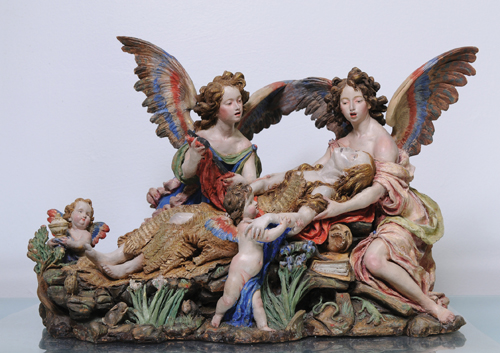
Luisa Roldán (1652-1706), Death or Ecstasy of St. Mary Magdalene, ca. 1690, The Hispanic Society of America, New York
by David St.-Lascaux
When one thinks of the great Spanish painters in New York – El Greco, Velázquez and Goya, for example, the Met comes first to mind. This is unfortunate, because some of the world’s finest Spanish art – and some of the rarest outside Spain – is ensconced in Washington Heights at the newly renovated, recently fêted (May 7, 2010) Hispanic Society of America.
The Society, located at 155th and Broadway, site of the Nineteenth-Century home of naturalist John James Audubon (also former site of the Heye Foundation’s Museum of the American Indian, and near the Morris-Jumel Mansion, Washington’s Revolutionary War headquarters at 160th Street), was founded in 1904 by Archer Milton Huntington, and its museum opened in 1908. In 1909, the Museum held an exhibition of the then-living artist Joaquín Sorolla y Bastida, peer contemporary of John Singer Sargent.
Huntington was a collector and scholar of Hispanic art and culture: his wife, Anna Hyatt Huntington, was a sculptress whose monumental, equestrian El Cid and other works occupy the Museum’s Audubon Terrace courtyard. According to Mencia Figueroa, the Society’s Coordinator, Development and Public Relations, Huntington acquired most his collection from Paris, “because he was a great believer in not buying anything from Spain, because he didn’t want to [pillage] the country.”
As the Society states, “La Hispanic Society es la colección más importante de arte y cultura del mundo hispano en los Estados Unidos, y la más significativa en el mundo” (“The Hispanic Society is the most important repository of art and culture of the Hispanic world in the United States, and one of the most important collections in the world”). Its collections include “more than 800 paintings… over 1,000 watercolors and drawings… almost 1,000 works of sculpture from the first millennium B.C. to the early twentieth century… more than 6,000 examples of ceramics, glass, furniture, textiles, ironwork and jewelry… 15,000 prints… over 175,000 photographs…” and a “comprehensive collection of textiles.” The Society’s library contains more than 450,000 books and manuscripts, “including 15,000 volumes printed before 1701” and a first-edition copy of Cervantes’s classic Don Quijote.
Upon entering the Museum’s terra cotta tiled courtyard, formerly the Library’s reading room, one immediately encounters Francisco José de Goya y Lucientes’s imperiously profiling “Portrait of the Duchess of Alba” (1797; she points to the ground, where is written the probably double entendre “Solo Goya” – “Goya Alone”). Upstairs, an encircling mezzanine presents in chronological progression Doménikos Theotokópoulos’s (El Greco’s) utterly singular “The Holy Family” (1585), Diego Velázquez’s petite “Portrait of a Little Girl” (c. 1638-44), additional Goyas, and Huntington’s collected contemporary artists, including Sorolla, whose 1911 portrait of Louis Comfort Tiffany at his easel in three-piece whites, smothered in flowers, defines the words “vivid” and “opulent.” A striking favorite, the “modern,” Chagallesque “Muchachas de Burriana” by Hermenegildo Anglada Camarasa (before 1911), features three young women in festive finery before a dapple horse.
A highlight of the Museum is the Sorolla Gallery, an expansive room in which the artist’s Visión de España (“Vision of Spain”) covers all four walls. Created in 1911-1919 expressly for the Society, Visión de España comprises fourteen canvases totaling 230 feet in length and 11.5 feet tall depicting the people, landscapes and customs of the nine regions of Spain.
Two important but underexposed artists in the Society’s collection are Francisco de Zurbarán (1598-1664), whose represented works include “Santa Rufina” (c. 1635), and Luisa Roldán (1652-1706), a prolific sculptress whose recently restored polychromed terra cotta “Death or Ecstasy of St. Mary Magdalene” shares the entry court with Goya’s “Alba.” As a female sculptor, Roldán was far ahead of her time, and the Society’s examples (a second, of the Holy Family in Egypt, is under restoration) are unique in New York and, indeed, the world. Conservator Hélène Fontoira Marzin, involved in both restorations, says that the Society shows visitors “the before and after,” enabling them to appreciate the magic of restoration. The Society’s approach, she says, is to make all restorations (the Roldáns taking about two months each) potentially reversible.
The Society’s collections also include archaeological artifacts dating from 1500 BCE, Celtiberian jewelry from 125 BCE, Roman-era mosaics and trullæ (ladles), Moorish ironwork and textiles. Prints and photographs include “almost all of Goya’s prints,” including his bats-and-cats-and-owls “The Sleep of Reason Produces Monsters” from Los Caprichos (1799). The Library contains a Zapotec genealogy from the 1570s and a must-see 1526 Siglo de Oro (Golden Age) map of the world by Juan Vespucci showing the entirety of Africa but very little of the unexplored west coasts of either North or South America. This seemingly anachronistic, even insignificant object is precisely opposite – that is, highly significant – as an example of the importance of cartography to navigation and Spain’s global empire. In fact, Spain had a department devoted to mapmaking, and required that the secret master world map, the Padrón Real, be kept onboard all Spanish ships at the time.
All in all, the Society’s collection is above criticism, containing as it does major artistic and cultural masterpieces of Spanish and New World Civilizations. And if one can’t expect to be a complete artist without experiencing art, the Society is a mandatory destination in New York City. Take the No. 1 to 157th, or the C to 155th, and experience los tesoros hispana de Nueva York.
* * *

